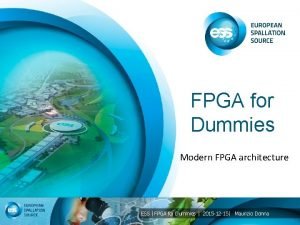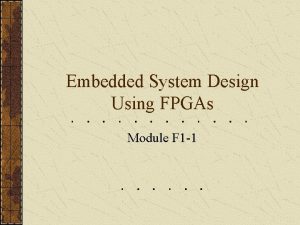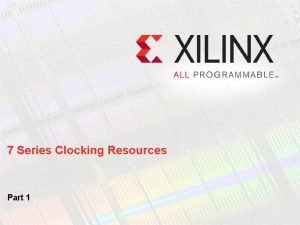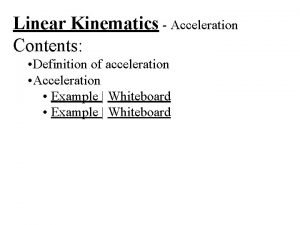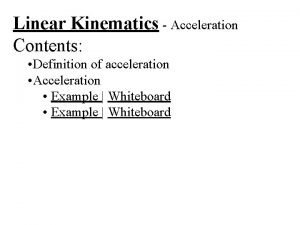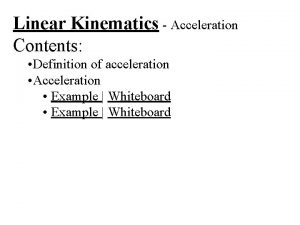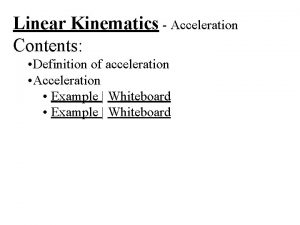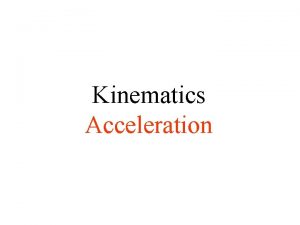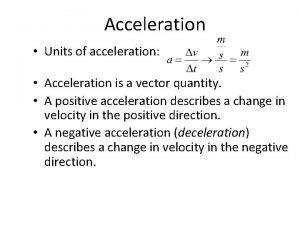FPGAs for the Masses Hardware Acceleration without Hardware




























- Slides: 28

FPGAs for the Masses: Hardware Acceleration without Hardware Design David B. Thomas dt 10@doc. ic. ac. uk

Contents • Motivation for hardware acceleration – Increase performance, reduce power – Types of hardware accelerator • Research achievements – Accelerated Finance research group – Research direction and publications • Highlighted contribution: Contessa – Domain specific language for Monte-Carlo – Push-button compilation to hardware • Conclusion

Motivation • Increasing demand for High Performance Computing – Everyone wants more compute-power – Finer time-steps; larger data-sets; better models • Decreasingle-threaded performance – Emphasis on multi-core CPUs and parallelism – Do computational biologists need to learn PThreads? • Increasing focus on power and space – Boxes are cheap: 16 node clusters are very affordable – Where do you put them? Who is paying for power? • How can we use hardware acceleration to help?

Types of Hardware Accelerator • GPU : Graphics Processing Unit – Many-core - 30 SIMD processors per device – High bandwidth, low complexity memory – no caches • MPPA : Massively Parallel Processor Array – Grid of simple processors – 300 tiny RISC CPUs – Point-to-point connections on 2 -D grid • FPGA : Field Programmable Gate Array – Fine-grained grid of logic and small RAMs – Build whatever you want

Hardware Advantages: Performance • • More parallelism - more performance GPU: 30 cores, 16 -way SIMD MPPA: 300 tiny RISC cores FPGA: hundreds of parallel functional units A Comparison of CPUs, GPUs, FPGAs, and MPPAs for Random Number Generation, D. Thomas, L. Howes, and W. Luk , In Proc. of FPGA (To Appear) , 2009

Hardware Advantages: Power • GPU: 1. 2 GHz - same power as CPU • MPPA: 300 MHz - Same performance as CPU, but 18 x less power • FPGA: 300 MHz - faster and less power A Comparison of CPUs, GPUs, FPGAs, and MPPAs for Random Number Generation, D. Thomas, L. Howes, and W. Luk , In Proc. of FPGA (To Appear) , 2009

FPGA Accelerated Applications • Finance – 2006: Option pricing: – 2007: Multivariate Value-at-Risk: – 2008: Credit-risk analysis: 30 x 33 x 60 x CPU Quad CPU 100 x Quad CPU 4 x 1. 1 x Quad CPU GPU • Bioinformatics – 2007: Protein Graph Labelling: • Neural Networks – 2008: Spiking Neural Networks: All with less than a fifth of the power

Problem: Design Effort • Researchers love scripting languages: Matlab, Python, Perl – Simple to use and understand, lots of libraries – Easy to experiment and develop promising prototype • Eventually prototype is ready: need to scale to large problems – Need to rewrite prototype to improve performance: e. g. Matlab to C – Simplicity of prototype is hidden by layers of optimisation

Problems: Design Effort • GPUs provide a somewhat gentle learning curve – CUDA and Open. CL almost allow compilation of ordinary C code • User must understand GPU architecture to maximise speed-up – Code must be radically altered to maximise use of functional units – Memory structures and accesses must map onto physical RAM banks • We are asking the user to learn about things they don’t care about

Problems: Design Effort • FPGAs provide large speed-up and power savings – at a price! – Days or weeks to get an initial version working – Multiple optimisation and verification cycles to get high performance • Too risky and too specialised for most users – Months of retraining for an uncertain speed-up • Currently only used in large projects, with dedicated FPGA engineer

Goal: FPGAs for the Masses • Accelerate niche applications with limited user-base – Don’t have to wait for traditional “heroic” optimisation • Single-source description – The prototype code is the final code • Encourage experimentation – Give users freedom to tweak and modify • Target platforms at multiple scales – Individual user; Research group; Enterprise • Use domain specific knowledge about applications – Identify bottlenecks: optimise them – Identify design patterns: automate them – Don’t try to do general purpose “C to hardware”

Accelerated Finance Research Project • Independent sub-group in Computer Systems section – EPSRC project: 3 years, £ 670 K • “Optimising hardware acceleration for financial computation” – Team of four: Me, Wayne Luk, 2 Ph. D students • Active engagement with financial institutes – Six month feasibility study for Morgan Stanley – Ph. D student funded by J. P. Morgan • Established a lead in financial computing using FPGAs – 7 journal papers, 17 refereed conference papers – Book chapter in “GPU Gems 3”

Finance: Increasing Automation

Finance: Increasing Performance

Contessa: Overall Goals • Language for Monte-Carlo applications • One description for all platforms – FPGA family independent – Hardware accelerator card independent • • “Good” performance across all platforms No hardware knowledge needed Quick to compile It Just Works: no verification against software

FPGA : Field Programmable Gate Array • Grid of logic gates – No specific function – Connect as needed

FPGA : Field Programmable Gate Array • Grid of logic gates – No specific function – Connect as needed • Allocate logic – Adders, multipliers, RAMs • Area = performance – Make the most of it – Fixed-size grid

FPGA : Field Programmable Gate Array • Grid of logic gates – No specific function – Connect as needed • Allocate logic – Adders, multipliers, RAMs • Area = performance – Make the most of it • Pipelining is key – Lots of registers in logic – Pipeline for high clock rate

FPGA : Field Programmable Gate Array • Grid of logic gates – No specific function – Connect as needed • Allocate logic – Adders, multipliers, RAMs • Area = performance – Make the most of it • Pipelining is key – Lots of registers in logic – Pipeline for high clock rate • Multi-cycle feedback paths – Floating-point: 10+ cycles

Contessa: Basic Ideas • Contessa: Pure functional high-level language – Variables can only be assigned once – No shared mutable state • Continuation-based control-flow – Iteration through recursion – Functions do not return: no stack • Syntax driven compilation to FPGA – No side-effects: maximise thread-level parallelism – Thread-level parallelism allows deep pipelines – Deep pipelines allow high clock rate - high performance • Hardware independent – No explicit timing or parallelism information – No explicit binding to hardware resources

• Familiar semantics – Looks like C – Behaves like C – No surprises for user • Built-in primitives – Random numbers – Statistical accumulators – Map to FPGA optimised functional units • Restricts choices – User can’t write poorly performing code – e. g. Just-in-time random number generation • Straight to hardware – No hardware hints – Push a button

• Each function is a pipeline – Parameters are inputs – Function calls are outputs – Can be very deep pipelines – Floating-point: 100+ cycles • Function call = continuation – Tuple of target + arguments – Completely captures thread – Can be queued and routed • Massively multi-threaded – Threads are cheap to create – Route threads like packets – Queue threads in FIFOs

Convert Functions to Pipelines void step(int t, float s) { float ds=s+rand(); step(t+1, ds); }

Nested Loops void outer(. . . ) { if(. . . ) outer(. . . ); else if(. . . ) inner(. . . ); else acc(); } void inner(. . . ) { if(. . . ) inner(. . . ); else outer(. . . ); }

Replicating Bottleneck Functions void init() { step(. . . ); } void step(. . . ) { if(. . . ) step(. . . ); else acc(. . . ); } void acc(. . . ) {. . . }

Contessa: User Experience • True push-button compilation – Hardware usage is transparent to user – High-level source code through to hardware • Progressive optimisation: speed vs startup delay – – Interpreted: immediate Software: 1 -10 seconds Hardware: 10 -15 minutes No alterations to source code • Speedup of 15 x to 60 x over software – Greater speedup in more computationally intensive apps. • Power reduction of 75 x to 300 x over software – 300 MHz FPGA vs 3 GHz CPU

Contessa: Future Work • Scaling across multiple FPGAs – Easy to move thread-states over high-speed serial links – Automatic load-balancing • Move threads between FPGA and CPU/GPU – Some functions are infrequently used: place in CPU – Threads move seamlessly back and forth • Automatic optimisation of function network – Replication of bottleneck functions – Place lightly loaded functions in slower clock domains • Allow more general computation – Fork/join semantics – Dynamic data structures

Conclusion • Goal: hardware acceleration of applications – Increase performance, reduce power – Make hardware acceleration more widely available • Achievements: accelerated finance on FPGAs – Three year EPSRC project: 25 papers (so far) – Speedups of 100 x over quad CPU, using less power – Domain specific language for financial Monte-Carlo • Future: ease-of-use and generality – Target more platforms, hybrids: CPU+FPGA+GPU – DSLs for other domains: bioinformatics, neural nets
 Fpga for dummies
Fpga for dummies Embedded microprocessor system design using fpgas
Embedded microprocessor system design using fpgas 7 series clocking resources
7 series clocking resources Radial acceleration formula
Radial acceleration formula Linear acceleration vs tangential acceleration
Linear acceleration vs tangential acceleration Vertical
Vertical Tangential acceleration and centripetal acceleration
Tangential acceleration and centripetal acceleration Relation between angular and linear quantities
Relation between angular and linear quantities The father in the poem without title
The father in the poem without title Justify the title keeping quiet
Justify the title keeping quiet Diane glancy without title
Diane glancy without title Hardware internal and external
Hardware internal and external Stickprovsvariansen
Stickprovsvariansen Rutin för avvikelsehantering
Rutin för avvikelsehantering Läkarutlåtande för livränta
Läkarutlåtande för livränta Kontinuitetshantering i praktiken
Kontinuitetshantering i praktiken Treserva lathund
Treserva lathund Myndigheten för delaktighet
Myndigheten för delaktighet Hur skriver man en tes
Hur skriver man en tes Tack för att ni lyssnade
Tack för att ni lyssnade En lathund för arbete med kontinuitetshantering
En lathund för arbete med kontinuitetshantering Tobinskatten för och nackdelar
Tobinskatten för och nackdelar Tack för att ni har lyssnat
Tack för att ni har lyssnat Biologiska arvet
Biologiska arvet Byggprocessen steg för steg
Byggprocessen steg för steg Rbk fuktmätning
Rbk fuktmätning Lufttryck formel
Lufttryck formel Presentera för publik crossboss
Presentera för publik crossboss Kung som dog 1611
Kung som dog 1611
